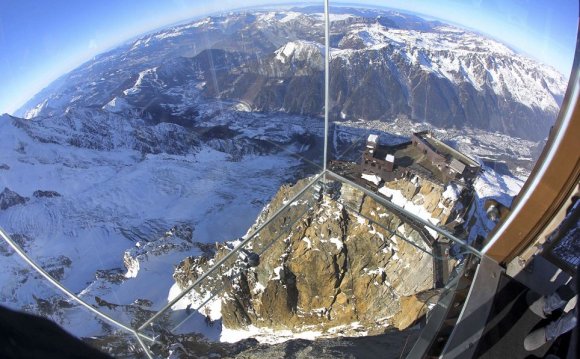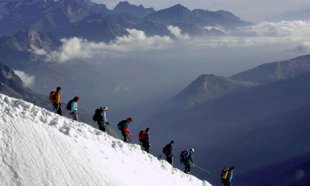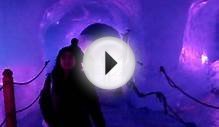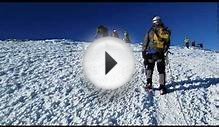
 As well as being beautiful, the route up Mont Blanc is easy to access via the Aiguille du Midi cable car from the French mountain town of Chamonix.
As well as being beautiful, the route up Mont Blanc is easy to access via the Aiguille du Midi cable car from the French mountain town of Chamonix.
Most fine spring and summer days will see a steady stream of climbers making their way up the slopes of Mont Blanc de Tacul, which leads to the traverse that takes in the summits of both Mont Maudit and Mont Blanc itself.
At the beginning of the summer Alpine season this year, while ice climbing one of the couloirs that overlooks the approach, I watched a steady crocodile, some carrying skis, setting off for their ascent.
The climb is little more than a steep slog at altitude – which many guiding companies offer to complete novices at the end of a week's course — but the dangers on this route are evident from the beginning.
There is a crevassed glacier approach and an initial ascent up a steep gradient threatened by large seracs – steep and sometimes unstable glacial ice cliffs.
With little in the way of rock buttresses on the ascent, the slopes can also be prone to avalanche, depending on the temperature, the wind and recent snowfall.
While the media tend to focus on deaths on Everest and other Himalayan mountains, the sad reality is that most mountaineers will die not on an expedition to remote peaks but in some of the world's most easily accessible mountains, serviced by cable cars and large alpine huts whose facilities are sometimes close to that of a hotel.
It is this easy access, and the fact that many summits are little more than a strenuous day out, that can breed complacency.
Every year scores of climbers die in the European alps. In one now notorious month in July 2007, the death toll on Mont Blanc and its satellite peaks reached 30 in a summer of bad weather.
Thursday's accident – the worst avalanche above Chamonix in recent memory – comes in the midst of another unsettled summer which has already seen several deaths, including five Germans killed in a single incident in Switzerland earlier this month.
Some fatalities are simply bad luck. Mountaineering, more than rock climbing, requires an acceptance of a different level of exposure to risk outside of the climber's control. These are referred to as "objective hazards" and include falling blocks, lightning strikes or a storm arriving earlier than forecast. Others, however, are avoidable.
Most people – like myself – climb in their holidays. It is fun, sociable and challenging. But mountain weather can be notoriously unreliable and seeing that time get eaten up by a series of storms, as the Alps have seen this year in spades, can push people to take risks just to "get something done". But as one of Britain's leading mountaineers told me in Chamonix earlier this year, the mountains "don't care if you're on holiday".
For younger climbers too, starting out in alpinism, the first experience on bigger mountains is a steep learning curve. There are new skills to learn, such as safe glacier travel, including how to recover from a roped fall into a crevasse.
I remember my first alpine season. Despite being an experienced rock climber and Scottish winter mountaineer, the addition of glaciers and altitude and the sheer scale of the mountains, made everything seem terrifying.
Straightforward tasks, such as abseiling, on a large, loose mountain are suddenly more daunting and difficult. Finding one's way down, dehydrated and exhausted, in a storm or after dark following a long day that might have begun at 2am requires the kind of stamina and attention that most of us, no matter how fit, don't experience on a day-to-day basis.
Global warming has also made the European Alps more dangerous. While falling rock has always been a hazard for alpinists, the melting of the permafrost that has for long acted as a glue for some large rock features has made them desperately unstable.
In recent years a series of massive rock falls have seen the collapse of large sections of the Dru, an elegant pillar overlooking the village of Argentiere.
Sometimes, however, there is not much rhyme or reason to these accidents: a too warm morning, a slope less stable than anticipated. And with so many people climbing on it … all the ingredients for a tragedy.
blogging podcast blogging quotes blogging questions blogging quiz blogging qna blogging que es blogging quora blogging questions for students blogging quotes goodreads blogging rules blogging resume blogging retreat blogging rubric blogging ring light blogging routine blogging revenue blogging recipes blogging sites blogging software blogging sites for free blogging statistics blogging salary blogging synonym blogging services blogging the boys blogging the bracket blogging topics blogging the boys trolling the nation blogging to make money blogging the boys podcast blogging theology youtube blogging under a pen name blogging university blogging using google sites blogging unscramble blogging under pseudonym blogging unscripted blogging udemy blogging uses blogging vs vlogging blogging vs youtube blogging vs vlogging 2021 blogging vs podcasting blogging vs microblogging blogging video camera blogging vs journaling blogging vs instagram blogging websites blogging websites that pay blogging wizard blogging with squarespace blogging website builder blogging websites to make money blogging with google sites blogging without social media bloggingx bloggingx pro bloggingx pro free download xkcd blogging xanga bloggingYOU MIGHT ALSO LIKE












